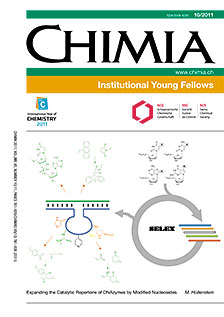Water-stable fac-{TcO3}+ Complexes – A New Field of Technetium Chemistry
DOI:
https://doi.org/10.2533/chimia.2011.776Keywords:
Alkenes, (3 2)-cycloaddition, Labeling, Radiopharmacy, TechnetiumAbstract
The development of technetium chemistry has been lagging behind that of its heavier congener rhenium, primarily because the inherent radioactivity of all Tc isotopes has limited the number of laboratories that can study the chemistry of this fascinating element. Although technetium is an artificial element, it is not rare. Significant amounts of the isotope 99Tc are produced every day as a fission byproduct in nuclear power plants. Therefore, a fundamental understanding of the chemistry of 99Tc is essential to avoid its release into the environment. In this article the chemistry of technetium at its highest oxidation state (+VII) is reviewed with a special focus on recent developments which make water-stable complexes of the general type [TcO3(tacn-R)]+ (tacn-R = 1,4,7-triazacyclononane or derivatives) accessible. Complexes containing the fac-{TcO3}+ core display a unique reactivity. In analogy to [OsO4] and [RuO4], complexes containing the fac-{TcO3}+ core undergo with alkenes metal-mediated, vicinal cis-dihydroxylation reactions (alkene-glycol interconversion) in water via a (3+2)-cycloaddition reaction. Therefore, water-stable fac-{99mTcO3}+ complexes pave the way for a new labeling strategy for radiopharmaceutical applications, based on (3+2)-cycloaddition reactions. This new concept for the labeling of biomolecules with small [99mTcO3(tacn-R)]+-type complexes by way of a (3+2)-cycloaddition with alkenes is discussed in detail. The herein reported developments in high-valent technetium chemistry create a new field of research with this artificial element. This demonstrates the potential of fundamental research to provide new impetus of innovation for the development of new methods for radiopharmaceutical applications.Downloads
Published
2011-10-26
Issue
Section
Scientific Articles
License
Copyright (c) 2011 Swiss Chemical Society

This work is licensed under a Creative Commons Attribution-NonCommercial 4.0 International License.
How to Cite
[1]
H. Braband, Chimia 2011, 65, 776, DOI: 10.2533/chimia.2011.776.







